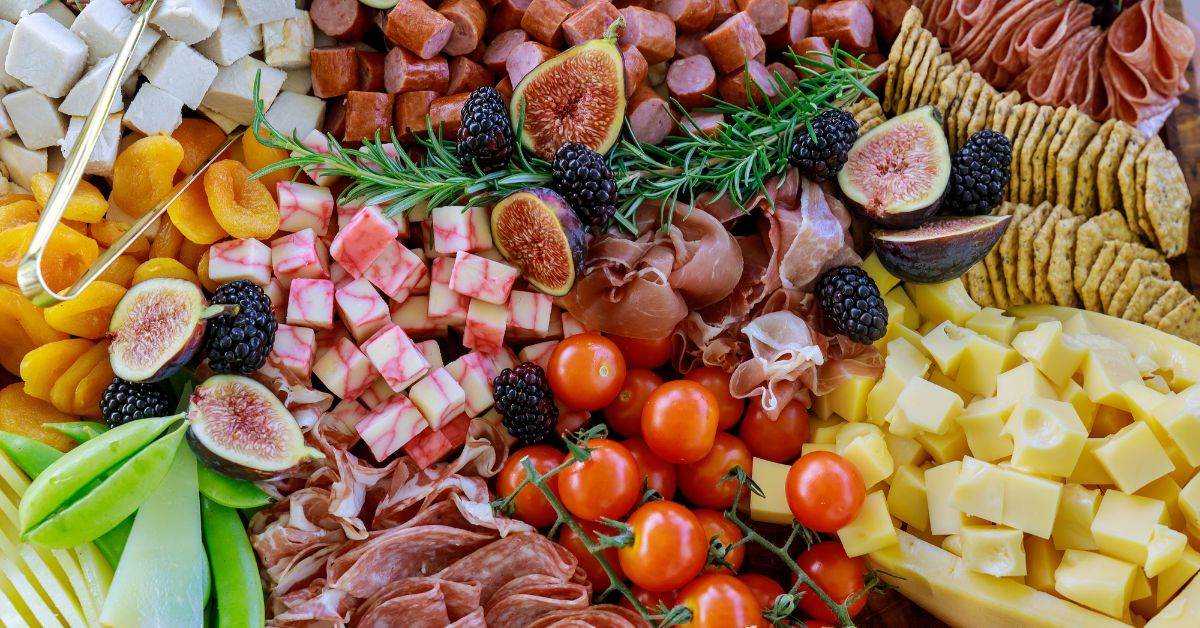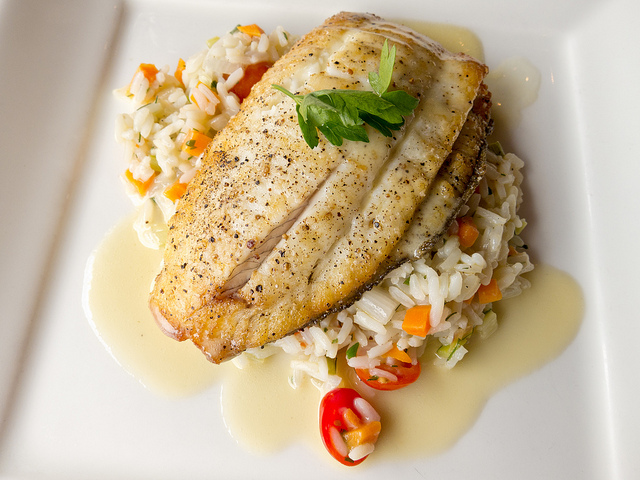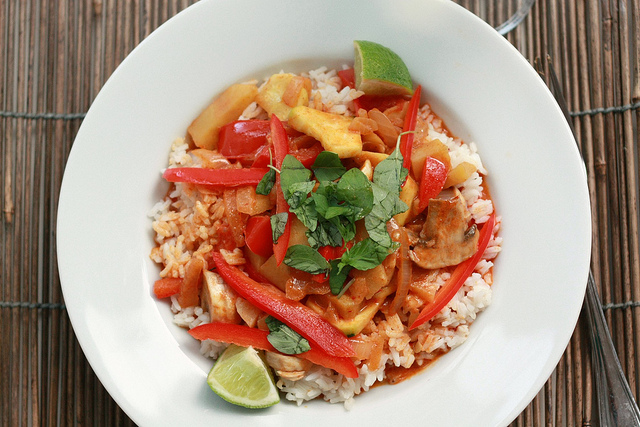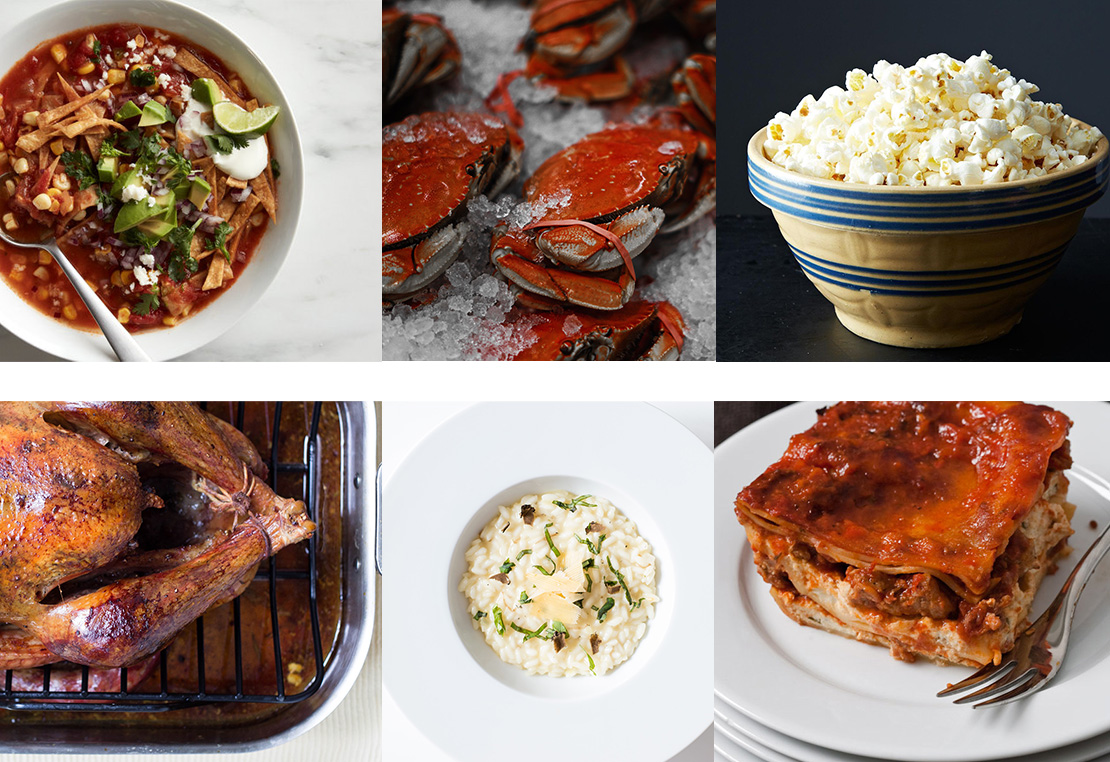Have company coming over? Charcuterie boards are your best friend, and our charcuterie board guide is your BESTEST friend. Find our go-to tips for charcuterie board shopping, charcuterie ingredients, and charcuterie board styling!
Components to a Perfect Charcuterie Board
When it comes to charcuterie, balance is everything. You aren’t just slapping meat and cheese on a wood slab, you’re crafting edible art. Keep these key principles in mind when building your masterpiece.
Texture
Gooey, crunchy, oily, creamy, chewy, crispy– the list goes on. A variety of textures is paramount when it comes to crafting a crowd-pleasing charcuterie spread. Try to cover at least four textures on your board.
Color
If you want your cheese board to look appetizing, add a variety of colors. My favorite way to maximize the color (and texture, for that matter) on my boards is to cut a portion of your fruits and vegetables before serving. Displaying the inside of your fruits and veg will add extra pops of color without adding on more ingredients.
Good options for this technique include apples, heirloom cherry tomatoes, oranges (extra points for blood oranges), persian cucumbers, and rainbow carrots.
Flavor
Sweet, salty, savory, briney, zesty, rich– Oh My! Your charcuterie board should cover several flavor profiles. The whole point of a charcuterie board is to mix and match flavor profiles with every bite– and having a wide flavor variety is what makes a charcuterie board great.
Charcuterie Board Ingredients
Here are some ingredients you may want to include in your charcuterie board.
Cheese
Cheese is the main character, and I prefer to add several different varieties to my board. I like to make sure every cheese on my board covers a different category. The seven categories of cheese are as follows:
- Fresh
Fresh cheese is made from curds that have not been through any pressing or aging. Think ricotta, mozzarella, cottage cheese, burrata, feta, and mascarpone.
Fresh cheese does not have a rind, and can be described as mild, creamy, salty, and tangy, and can range from in texture to spreadable and creamy to crumbly.
- Aged fresh
Fresh cheeses that have been left to age, resulting in a loss of moisture and the development of a thin rind.
- Soft white rind
This cheese style is characterized by its fuzzy white rind, made from penicillium candidum mold. The rind allows the cheese inside to become buttery, rich and smooth as it ages without drying out.
Soft white rind cheeses are my favorite to include on charcuterie boards. Think brie and camembert.
- Semi soft
Semi soft cheeses are firmer and contain less moisture than soft cheeses, their texture can be described as rubbery and elastic with a fine, leathery rind. Think provolone, gouda, muenster, havarti, and pepper jack.
- Hard
Hard cheeses have been pressed and aged, and contain very little water content. Think cheddar, pecorino, parmesan (especially aged Parmigiano Reggiano), and manchego.
- Blue
Blue cheese is made by adding blue penicillium mold to the curds, resulting in a creamy, pungent, and spicy flavor profile. Think gorgonzola, stilton, and roquefort.
- Flavored
Flavored cheeses have added ingredients like nuts, fruits, herbs, spices or mushrooms to enhance the overall flavor. Common flavored cheeses include goats cheese with dried berries, pecorino with truffle, and herbed gournay.
Cured Meats
If cheese is the main character, then your meats are the lovable and unforgettable side character. They offer a huge depth of flavor and gorgeous color. If you haven’t ventured far into the meat-o-sphere, now is the time to do so. It’s more than just salami and prosciutto out there.
Try adding coppa, smoked salmon, soppressata, mortadella, and Spanish chorizo to your board.
Starches
Starches are often overlooked, but can make all the difference. You have to spread your cheese on something, right? Go beyond water crackers– there is SO much more out there. Consider adding slices of soft french bread, hunks of ciabatta and focaccia, whole wheat crackers with dried berries and nuts, and even baked Parmesan crisps.
Spreads
Adding a spreadable something to your board will take things up a notch. I like to add small jars of honey, jams and marmalades, tapenade, pate, fruit dips, hummus, and fondue.
Fruits and Veg
Fresh is best! Shop in-season whenever you can. If the season allows, I like to add “wow factor” to my board in the form of variegated veg or tropical fruit. Blood oranges, passionfruit, dragon fruit, gooseberries, fresh figs, heirloom tomatoes, rainbow carrots, watermelon radish, and purple cauliflower tend to do the trick.
But there are times where there just isn’t any “wow factor” produce on the shelves. In that case, I put my knife skills to the test.
Using innovative cutting techniques can help you achieve an extra pop on your board. Who says you can’t crinkle-cut apple slices? Or slice your strawberries into hearts! Or even sub your salami rose with a radish rose?!?! The options are endless so get creative, folks!
Nuts, Seeds, and Something Sweet
Small snacks like nuts and seeds are a great way to fill empty spaces on your board. Add a handful of pistachios to a gap in the charcuterie harvest and viola– you have the cornucopia effect!
Throw the whole trail mix on! Chocolate pieces, yogurt covered pretzels, small candies, and dried fruits will make a big impact on your pairing possibilities.
Garnishes
The final step to a great charcuterie board is the garnish! Fresh flowers and herbs do the trick beautifully, but even a touch of oil on your hard cheeses and meats or a sprinkle of flaky sea salt can elevate your charcuterie board.
How Much Charcuterie Do You Need?
A good rule of thumb for calculating how much food you’ll need is to multiply the amount of guests by three. You should have about three ounces of cheese and three ounces of meat per person.
To make sure you have enough variety on your board, go by the 3x3x3 rule. Your board should minimally have three cheeses, three meats, and at least three accompaniments.
Charcuterie Styling Tips
Gathering your charcuterie ingredients is only half the battle, now it’s time to roll up your sleeves and get to your charcuterie design. Here are our tips for charcuterie styling.
Don’t Limit Yourself to the Board
I’m going to tell you what you’ve been waiting to hear: your charcuterie board is not the edge of the earth! There’s no need to squeeze all of your ingredients onto one board. Add extra boards, bowls, or baskets for bulky charcuterie ingredients. I prefer to keep breads and crackers off of my charcuterie arrangement to maximize space and minimize sogginess.
Cut the Cheese, Fold the Meats
Your main players need to be arranged with style! This is where most of your charcuterie-building efforts will be spent, but the payoff is huge! Not only does it add worlds of dimension to your charcuterie, properly cutting and serving your ingredients will make it easier for guests to eat.
Here are some basic cheese board cutting, cured meat rolling, and serving techniques that will elevate your charcuterie board presentation:
Cheese Slicing Techniques
- Wedge Cut:
Slice hard cheese into triangular wedges. Start cutting from the center and work your way outward, maintaining equal thickness throughout. This method is ideal for medium to hard cheeses like cheddar, gouda, or manchego.
- Natural Crumbles:
For hard cheeses like parmesan, aged gouda, and pecorino, opt to crumble the wedge instead of slicing it. This will add a rustic, organic feel to your board.
3.Slice and Fan:
Take a semi-hard or hard cheese like parmesan or manchego and cut it into thin slices. Arrange the slices in a fanned-out pattern on the board. This method not only looks elegant but also allows guests to pick up the slices cleanly.
Cured Meat Styling Techniques
- Prosciutto Roses:
Take thin slices of prosciutto and roll them into tight spirals to create elegant “roses.” These can be placed in clusters or scattered around the board for a visually striking effect. The more advanced version of this technique involves folding many slices over and around the rim of a wine glass.
- Salami Folds:
Fold pieces of salami in half to create a half circle shape. Then fold them in half again, this will create a rounded triangle look. Stack your folded slices together, side by side, with the points facing down until you have a trail of ruffled salami along your board. The layered, rounded edges will provide tons of dimension and texture to your charcuterie spread.
- Coppa Rolls:
Coppa is a cured meat with a rich marbling of fat. To create attractive coppa rolls, fold the slices in half lengthwise and then roll them up into small cylinders. This showcases the marbled appearance and enhances the overall visual appeal.
Charcuterie Board Wine Pairings
What’s a charcuterie board without some sipping to go along with it? Here are our favorite wines to pair with your charcuterie spread.
Pinot Noir
For a classic charcuterie board featuring an assortment of cured meats like prosciutto, salami, and chorizo, a Pinot Noir makes an excellent wine pairing. The wine’s red fruit aromas, such as cherry and raspberry, complement the rich, savory flavors of the charcuterie. Pinot Noir’s subtle earthy undertones and soft tannins enhance the overall experience by providing a smooth contrast to the saltiness of the meats. Additionally, the wine’s medium body and balanced acidity ensure it won’t overpower the delicate flavors of the charcuterie, allowing both the wine and the food to shine together harmoniously.
Dry Rosé
When assembling a charcuterie board with a mix of hard and soft cheeses, along with dried fruits and nuts, a dry Rosé wine offers a splendid pairing choice. The wine’s bright and refreshing red fruit aromas, such as strawberry and watermelon, complement the variety of flavors on the board, enhancing the overall tasting experience. Dry Rosé’s crisp acidity and light body make it versatile enough to handle the diverse textures and tastes of the charcuterie components. Its subtle mineral notes and hints of herbs add an extra layer of complexity, elevating the flavors of both the cheese and the meats.
Grüner Veltliner
Grüner Veltliner is a white wine primarily grown in Austria, and it offers a distinctive flavor profile that includes notes of green apple, white pepper, and citrus. Its crisp acidity makes it an excellent match for the creaminess of brie cheese. The wine’s herbal and peppery undertones complement the cheese, adding complexity to the pairing.
Go-To Charcuterie Board Recipes
Tuscan Charcuterie
Cheeses:
- Pecorino Toscano: A classic Tuscan sheep’s milk cheese with a semi-firm texture and a slightly nutty, savory taste.
- Taleggio: An Italian cheese from Lombardy, known for its creamy interior and tangy, fruity flavors.
- Whipped Ricotta: Fresh ricotta cheese, whipped in a food processor and spiced with fresh rosemary, basil, and salt. Topped with a drizzle of olive oil.
Cured Meats:
- Prosciutto: Thinly sliced dry-cured ham with a delicate, melt-in-your-mouth texture.
- Salami Toscano: A traditional Tuscan dry salami with a rich and robust flavor, often seasoned with garlic and peppercorns.
- Finocchiona: A unique Tuscan salami flavored with fennel seeds, which lend a pleasant herbal note.
Accompaniments:
- Bruschetta: Toasted bread rubbed with garlic and topped with ripe diced tomatoes, basil, and extra virgin olive oil.
- Grissini: Crispy Italian breadsticks, perfect for adding a crunchy element to the board.
- Olives: An assortment of marinated and cured olives, such as Kalamata or Castelvetrano, for a burst of briny flavors.
- Marinated Artichokes: Tender artichoke hearts marinated in herbs and oil, providing a tangy and aromatic addition.
Fruits and Nuts:
- Fresh grapes
- Figs: Fresh or dried figs, adding a touch of sweetness and a delightful texture contrast.
- Toasted Marcona Almonds: Crunchy, toasted almonds that pair well with the cheeses and offer a nutty flavor, you can find a variety of Marcona almonds at Trader Joes!
Baked Brie Board
Baked brie always rocks the house down. Add some sweet and savory elements and BOOM! You have an absolutely killer board. Here’s what you’ll need:
Baked Brie:
See recipe here!
- 1 round of brie cheese (approximately 8-10 ounces)
- 1 sheet of puff pastry (store-bought or homemade)
- 1 egg (beaten, for egg wash)
- Brown sugar
- Maple syrup
- Fruit jam of your choice
Assorted Cheeses:
Your bakes brie likely won’t last long (it’s that good), so I like to add additional assorted cheeses to the board. Add manchego, boursin, aged parmigiano, or goat cheese to supplement your baked brie centerpiece!
Cured Meats:
- Prosciutto
- Salami (choose your favorite variety, like Genoa or Soppressata)
- Chorizo or any other spicy cured sausage you prefer
Fresh Fruits:
- Green and red grapes
- Sliced apples or pears
- Fresh figs, when in season
- Berries
Final Words
Crafting a stunning charcuterie board is an art that can elevate any gathering to a memorable experience. By following our expert tips and guidelines, you can effortlessly create an impressive display of savory delights and visually appealing arrangements. Remember to balance flavors, textures, and colors, incorporating a diverse selection of cured meats, cheeses, fruits, nuts, and accompaniments. Embrace creativity in arranging the components, paying attention to symmetry and spacing. Whether you’re hosting an intimate gathering or a grand celebration, the charcuterie board will undoubtedly be the centerpiece that captivates and delights your guests. So, unleash your culinary flair– happy snacking!
Be sure to tag us in your charcuterie creations on Instagram at @lastbottlewines, and check out today’s offer of wine at 30-70% off retail!













